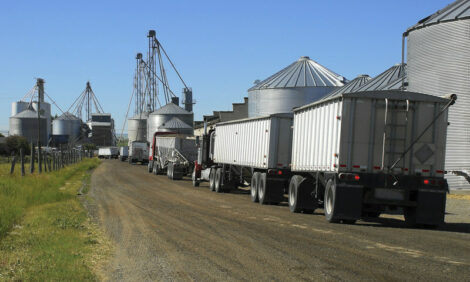



Schering-Plough launches first trivalent SIV vaccine
US - Schering-Plough Animal Health has launched Maxivac® Excell 3, the industry's first trivalent vaccine for the costly swine influenza virus (SIV).Schering-Plough Animal Health Corporation has once again raised the bar for swine influenza protection by introducing the industry's first trivalent vaccine for the costly swine influenza virus (SIV).
MaxiVac® Excell™ 3, a killed-virus vaccine, protects against all major strains of swine flu virus (SIV) circulating in the U.S. swine population. It features a new variant or "reassortant" strain of the H1N1 subtype in addition to the classical H1N1 subtype that has been circulating in U.S. hogs for decades.
The vaccine also contains an H3N2 subtype that protects against the Cluster I Texas-like H3N2 subtype, as well as cross protects against the Cluster III variants of H3N2.  "MaxiVac Excell 3 fills an unmet need and gives the pork industry a new tool for managing SIV," says Luis Fernandez, DVM, senior product manager for swine products at Schering-Plough Animal Health Corporation. "No vaccine provides broader flu protection against the most predominant strains in U.S. swine herds."
"MaxiVac Excell 3 fills an unmet need and gives the pork industry a new tool for managing SIV," says Luis Fernandez, DVM, senior product manager for swine products at Schering-Plough Animal Health Corporation. "No vaccine provides broader flu protection against the most predominant strains in U.S. swine herds."
Reassortant H1N1
The new strain - known as reassortant H1N1 (rH1N1) - emerged from a process called genetic reassortment, which occurs when a single cell is infected by two different influenza viruses. The result is a "progeny virus" containing genetic material from both "parents."
In the case of the reassortant H1N1, the hemagglutinin (HA) and neuraminidase (NA) are derived from the classical H1N1 (cH1N1) virus, but internal polymerase genes are derived from the H3N2 virus.
"In other words, the outside of rH1N1 looks like a classical H1N1, but its internal genes are derived from H3N2," explains Robyn Fleck, DVM, swine technical service veterinarian for Schering-Plough Animal Health. "Reassortant H1N1 also acts differently from the old classical H1N1. It picks up mutations at an increased rate, thereby evading the pig's immune system."
Hard to diagnose
Reassortant H1N1 presents practical problems for pork producers, Fleck says. Because it has different antigenic behavior than classical H1N1, outbreaks of rH1N1can occur in herds that have been vaccinated against classical H1N1.
"In fact, while results haven't been published, diagnosticians throughout the United States who perform genetic sequencing of SIV isolates say most H1N1s today are rH1N1, not classical H1N1," she says.
Still, it's not easy to tell if rH1N1 exists in a particular swine herd. "It's hard to get a quick, accurate diagnosis with conventional testing. Differentiating rH1N1 from classical H1N1 requires genetic sequencing, which involves extra time and expense," she says.
The emergence of rH1N1 doesn't come as a complete surprise. At a SIV symposium at the 2002 Allen D. Leman Swine Conference, Dr. Richard Webby, a microbiologist, infectious diseases department, St. Jude Children's Research Hospital, reported that rH1N1 was becoming "one of the dominant viral genotypes" in U.S. swine. The swine population, he said, has changed from "a reservoir containing a single virus to one where H1N2, two antigenically distinct H3N2 and two distinct genotypes of H1N1 co-circulate."
Dr. Fleck notes that the prevalence of flu strains is in a state of flux, and that classical H1N1 is still a concern. "Now that we have both classical and reassortant H1N1 viruses circulating in U.S. swine herds, the broadest spectrum of protection will be obtained with a multivalent vaccine containing both H1N1 viruses, as well as the current strain of H3N2."
Trials show protection
Recent trials showed the significance of vaccinating for classical and reassortant H1N1 viruses. According to Fleck, pigs vaccinated with a vaccine containing only cH1N1+H3N2 were not protected when challenged with rH1N1. However, pigs injected with a vaccine containing rH1N1 had a statistically significant reduction in lung lesions after rH1N1 challenge, compared to unvaccinated controls and pigs injected with the cH1N1+H3N2 vaccine.
In another study, pigs were vaccinated twice 2 weeks apart with MaxiVac Excell 3 (cH1N1+rH1N1+H3N2). From 3 to 4 weeks after the second dose, they were challenged with either virulent rH1N1 or cH1N1. After 5 days, they were necropsied and their lungs were scored. MaxiVac Excell 3 significantly reduced lung lesions, as well as the percent of pigs positive for virus recovery from the lung tissue after both types of challenge. "The results demonstrate excellent efficacy, with no interference between antigens," Fleck says.
Pigs vaccinated with MaxiVac Excell 3 also showed significantly less nasal shedding of rH1N1, she says. Nasal swabs were collected daily from pigs after rH1N1 challenge and until necropsy. Overall, there was a 98.6% reduction in nasal viral titer during the 5 days after SIV challenge in pigs vaccinated with MaxiVac Excell 3, compared to unvaccinated controls. The difference was statistically significant.
"A reduction in nasal viral shed means less virus on the farm and a lower overall SIV challenge for all animals in the herd," Fleck says.
Proven safety in pigs, breeding stock
The strains in MaxiVac Excell 3 have been carefully selected and balanced for optimum performance. Because the vaccine contains Emunade®, the same proprietary adjuvant used for many years in the company's M+Pac® mycoplasma vaccine, MaxiVac Excell 3 can be used with confidence in sows or pigs with virtually no reactions or performance setbacks, according to Fleck.
MaxiVac Excell 3 is approved for use in pigs 5 weeks of age or older, including boars and pregnant sows, as an aid in the prevention of disease associated with the SIV subtypes rH1N1, cH1N1 and H3N2. The vaccine also has been shown to reduce pneumonia and lung infection following challenge. Schering-Plough Animal Health recommends vaccinating healthy pigs with a 2 mL intramuscular (IM) dose and revaccinating 2 to 3 weeks later.
"It's best to consult with your veterinarian for optimum vaccination timing to avoid interference with maternal antibodies from vaccinated sows," Fleck says.
Further information
For more information on Swine Influenza Virus Click Here For more information on Schering-Plough Click HereSource: Joseph Feeks, PR Works - 22nd December 2003










